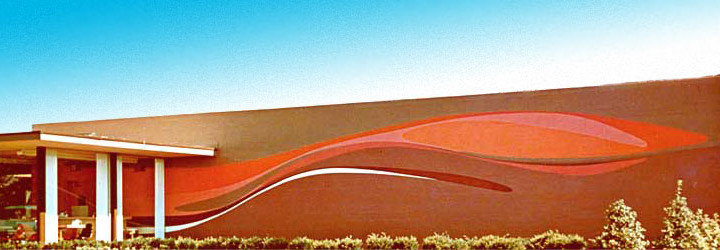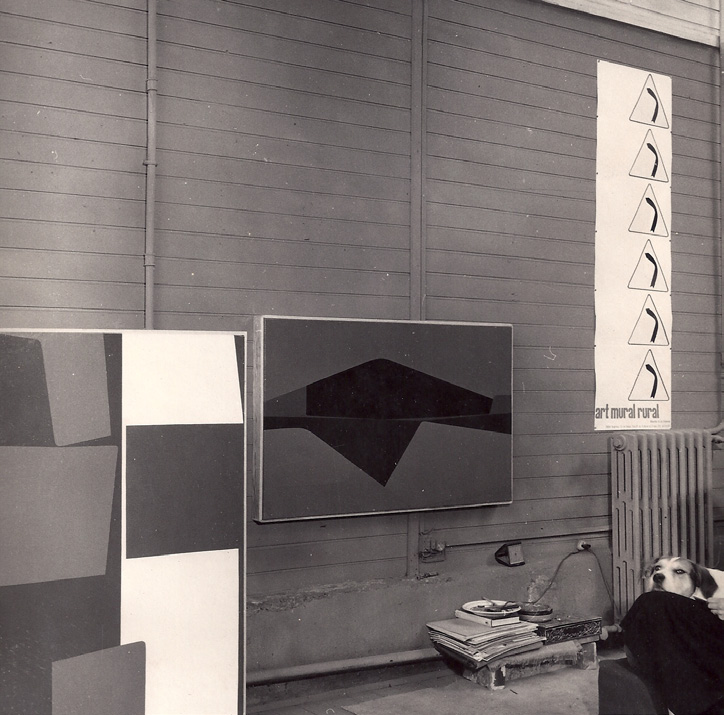Rural-Mural
Rural-Mural

The rural-mural was an idea originally conceived by Zimmerman in 1952 after spending time driving through the countryside of France. It combines his aesthetic of geometric abstraction, aggressive color palette and sense of visual drama with his philosophy that art should be available to the public, enrich their experience and enhance the beauty of public visual space.
The excerpt below, from a letter dated March 11, 1953, is a translation of the text on the invitation to Zimmerman’s Paris studio show of paintings. Composed by a French writer identified only as Alvard, it describes the concept for Zimmerman’s Rural Murals.
“Z. knows the dangers of publicity and the servitude that it can impose. But there is not adventure without danger. There exists along the highways great surfaces given over to the most mediocre usage of advertising which awaken the desire to make them serve more noble usages, and who knows maybe reconcile the natural beauty of the landscape that surrounds them. Zim. takes the problem in reverse. He reacts against the slavery of publicity in the hope to put, for one time, money at the service of art. What one sees on the walls on his studio it must be underlined are paintings, which if they are destined to be considerably enlarged demand to be judged as paintings. He has simply hunted for simple abstract forms to facilitate their reproduction but without sacrificing anything of their subtlety and their personality. As for the colors, they owe nothing to anything except the interior exigencies of the painter”
The rural-mural concept was articulated in a letter to his parents. January 21, 1952. Zimmerman writes, “There has been a lot of discussion on the subject of easel painting; its purpose, dissemination, and future. There are those who contend that the easel picture (that is as opposed to the mural painter) shall continue to exist in its present role, being shown in gal[l]eries, sold to collectioners, and museums, and being a possession of someone or a few for their individual pleasure. There is the opposing view toward easel painting which feels that the future of easel painting is very precarious. This form of art does not reach enough people to be effective as an art form, has too limited means and market to be a financial success, and is therefore doomed to a limited and precious existence…
“I suppose that you are asking me why I put all this emphasis on the importance of the presence of good form (in the general sense meaning shapes, colors, materials etc which are employed with the best of taste). I feel that good form is an absolute necessity in the psychological well being of the human being. You have heard of the results of experiments in industry on production by which the painting of a factory interior in more pleasant tones augmented production. This is one of the more simple effects of form on man. Environment plays a huge role in the psychic formation of a man’s character. The presence of art, whether it be music, architecture, sculpture or painting does have a very important effect also as a part of man’s env[iro]nment. But it is obviously ineffectual if it is seen only rarely, and then only when sought by those who feel the need. Good form is a spiritual food that is as necessary to the [spirit] as potatoes to the stomach. Those who are deprived of it are starving… You have gathered that I was planning to make some liaison between fine arts and commerce. This liaison takes the rather peculiar form of mural painting as a commercial art, advertising a product. But I feel that only [through] mural art can any number of people be affected. And here hangs the tail.
“Rural-Mural Barn painting: You know of course that there are several companies who find it efficace to advertise their products on the side of a barn, the whole side of the barn. Main Pouch, Bull Durham, Jefferson Island Salt. These ads are only ugly colored letters giving the name of the product. They are peut-être effective as ads, but a blight to the landscape. I have hit upon the marvelous idea of utilizing these huge surfaces for art. And art which will serve the second purpose as advertising”
In the November 1956 issue of Arts in Louisville, Zimmerman was able to announce that his vision for the rural-mural would come to life—only in a more urban environment, “On Shelbyville Road about one mile this side of the Watterson Expressway” at a drive-in restaurant owned by patron of the arts, Austin Pryor. Louisville architect, Norman Sweet designed the drive-in’s building and called Zimmerman with Pryor’s request, “Could a rural mural become suburban?”
Zimmmerman acquiesced and when completed, the mural was sixty-seven feet long and thirteen feet tall. “I hope that this mural becomes more than a source of shock to the 45,000 or so daily passers-before-it; that it becomes an added excitement in the landscape; that it bring[s] to those who pass a response of individual signification in this vast, exuberant, unwieldy, unsettling, modern human extravaganza”, Zimmerman wrote in Arts in Louisville. Pryor would also commission Zimmerman to design a forty-foot tall rotating hamburger sculpture for the restaurant. For five years the mural graced the wall of the drive-on on U.S. 60 until a later expansion of the building obscured the mural from view.

